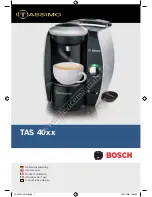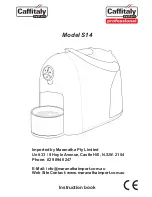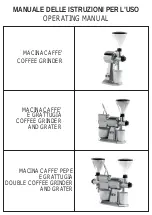
£
Place a sufficiently large bowl (about 0.5 l) under the steam/hot water jet/Spumatore.
£
Turn the steam/hot water control (fig. 1/C) clockwise.
The descaling program starts. Symbol S7
flashes. The descaling process is automatic and will run
for about 10 minutes. As soon as the first part of the program has finished, symbol S12
is on
and symbol S7
flashes.
£
Turn the steam/hot water selector (fig. 1/C) anti-clockwise.
The descaling program starts again, the descaler runs into the drip tray. Symbol S7
flashes. The
descaling process is automatic and will again run for about 10 minutes. Once the process has fin-
ished, symbol S2
is on and symbol S7
flashes.
£
Remove drip tray with used coffee container (fig. 1/O and P). Empty and clean both.
£
Reinsert drip tray and used coffee container.
Symbol S1
is on.
£
Remove water tank and rinse it with fresh water.
£
Reinsert filter if required.
£
Fill the water tank with fresh water.
£
Reinsert the water tank.
Symbol S12
is on.
£
Again place a sufficiently large bowl (about 0.5 l) under the steam/hot water jet/Spumatore.
£
Turn the steam/hot water control (fig. 1/C) clockwise.
The rinsing process through the steam/hot water jet /Spumatore starts.
£
Once the process has finished, symbol S7
flashes and symbol S12
is on.
£
Turn the steam/hot water control (fig. 1/C) anti-clockwise.
The internal rinsing program starts and will take about one minute, followed by a brief rinsing of the
coffee spout. The symbol S7
flashes and symbol S2
is on.
£
Remove drip tray with used coffee container (fig. 1/O and P) and empty both.
£
Reinsert drip tray and used coffee container.
The appliance briefly heats up. It is ready for use again when the bean symbols in the display are on.
Attention: Please remove any descaler residues on the casing immediately with a damp cloth.
Manual descaling
If required the descaling program can also be started and run as described above, without the prompt
of symbol S7
.
4.4 Regular cleaning by hand
Tip: Please follow these cleaning instructions as working with foodstuffs demands the highest degree of
cleanliness.
Attention: Never immerse the appliance in water! Do not use abrasive cleaning agents.
£
Empty drip tray and used coffee container regularly (fig. 1/O and P). The red floating indicator at
the back of the drip tray (fig. 1/Q) shows the tray’s filling level.
£
Only use a soft, damp cloth for cleaning the casing inside and outside.
£
Empty drip tray and used coffee container (fig. 1/O and P) at the latest when this is indicated on
the display (only when the appliance is switched on!).
Occasionally use a little soapy water for cleaning.
£
The water tank should be rinsed daily with clear water and then re-filled daily with fresh cool
water.
TIP: Dried milk residue is difficult to remove.
£
Therefore clean the steam/hot water jet/Spumatore, the suction hose regularly.
Attention: From time to time (ideally each time the appliance will not be used for a while, at any rate in
regular intervals!) the steam/hot water jet needs to be completely dismantled and thoroughly cleaned
under running water (fig.3). We recommend our special cleaning agent for milk residue NICC 705.
4.5 Cleaning the brew unit
Attention: Remove the brew unit only when the appliance is switched off.
When necessary the brew unit can be removed and cleaned under cold, running water. Never use
any cleaning agent, but clear, cold water only! For hygienic reasons we recommend the removal and
cleaning of the unit thoroughly after each run of the cleaning program (see chapter 4.2).
£
Open and remove the service door on the right of the casing (fig. 1/M).
£
Remove the brew unit by pressing the red switch and turning the handle all the way to the left
until it snaps into place (fig. 12).
£
Carefully remove the brew unit using the handle.
£
Clean the brew unit under running cold water and let it dry.
£
Reinsert the brew unit carefully and lock by pressing down the red switch and turning the handle
all the way to the right until it snaps into place.
£
Close the service door and in doing so carefully place the pivots at the back of the door into the
notches. Make sure that the door (fig. 1/M) completely snaps back into place.
18
19
GB
GB
4. Cleaning and maintenance
4. Cleaning and maintenance






























